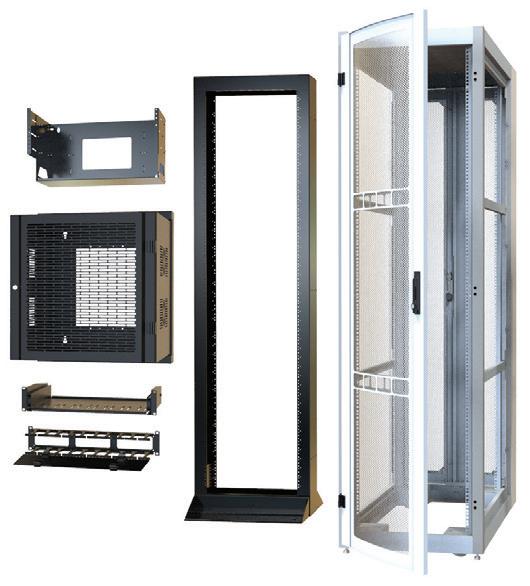






















In an increasingly interconnected and technolog ically driven world, the electronic component supply chain plays a pivotal role in shaping our daily lives. From smartphones and laptops to medical devices and electric vehicles, electronic components are the lifeblood of modern innovation. However, in recent times, this critical supply chain has been facing unprecedented challenges, and the ripple effects are being felt far and wide.
The seeds of this crisis were sown well before the current predicament.The global demand for electronic components has been steadily r ising, driven by a surge in consumer electronics, the rapid digitization of industries, and the proliferation of IoT devices. This ever-increasing demand was met with an increasingly complex and interdependent supply chain, making it vulnerable to disruptions.
One of the most glaring issues in this crisis is the vulnerability of the supply chain to geopolitical tensions. The world has witnessed how trade wars and export restrictions can severely impact the availability of essential components. For instance, trade tensions between the US and China led to disruptions in the semiconductor supply chain, affecting industries ranging from consumer electronics to automotive manufacturing. The lesson here is clear: a diversified, resilient supply chain is essential to withstand geopolitical shocks.
The ongoing global pandemic has also exposed the fragility of the electronic component supply chain. COVID-19 disrupted
manufacturing, transportation, and logistics worldwide, leading to shortages of critical components. The lockdowns and restr ictions imposed by various countries disrupted the production and shipment of electronics, leaving many industries scrambling for essential parts. This crisis highlighted the need for contingency plans and increased stockpiles of critical components to mitigate future disruptions.
Another critical issue is the concentration of production in a few key regions. The majority of semiconductor manufacturing is concentrated in East Asia, particularly Taiwan, South Korea, and mainland China. These global hubs are also susceptible to natural disasters. Thus, it is imperative that countries and companies consider diversifying production locations.
The component supply chain crisis has also underscored the need for innovation in materials and production techniques. For instance, the semiconductor industry is exploring alternative materials and manufacturing methods to reduce reliance on scarce resources and to increase production efficiency. Research into new materials like gallium nitride (GaN) and silicon carbide (SiC) promises more efficient and resilient components, but this requires time and money.
Collaboration is key to solving the current crisis. Governments, industries, and international organizations must come together to address these challenges collectively. Governments should incentivize domestic production of cr itical components, invest in R&D, and promote education and training in semiconductor manufacturing.
Moreover, there is a pressing
need for transparency and information sharing within the supply chain. Many companies are reluctant to disclose detailed information about their suppliers and supply chain operations due to concerns about intellectual property and competition. However, greater transparency can enable better risk assessment and collaborative problem-solving in times of crisis.
In novation in supply chain management is another avenue that deserves exploration. Advanced technologies like AI, blockchain and IoT can provide real-time visibility into the supply chain, enabling better forecasting, demand management, and risk assessment. These technologies can also enhance traceability, ensuring that components meet quality and ethical standards
Additionally, companies should consider implementing sustainable practices in the electronic component supply chain. The production of electronic components consumes significant energy and resources, and the industr y must work towards reducing its environmental footprint. Sustainable practices not only benefit the environment but also contribute to long-term supply chain stability by reducing resource scarcity risks.
Lastly, the electronic component supply chain crisis has e xposed vulnerabilities that demand immediate attention. As we navigate the storm, it is essential that all parties work together to secure the electronic component supply chain, ensuring that it remains the backbone of our technological progress and innovation.
STEPHEN LAW Editor slaw@ept.ca
Canada’s information leader for electronic engineers and designers
OCTOBER 2023
Volume 45, Number 7
READER SERVICE
Print and digital subscription inquiries or changes, please contact Angelita Potal
Tel: (416) 510-5113 Fax: (416) 510-6875
Email: apotal@annexbusinessmedia.com
Mail: 111 Gordon Baker Rd., Suite 400 Toronto, ON M2H 3R1
EDITOR Stephen Law slaw@ept.ca · (416) 510-5208
WEST COAST CORRESPONDENT Sohail Kamal · sohail@nextgear.ca
SENIOR PUBLISHER Scott Atkinson satkinson@ept.ca · (416) 510-5207
ACCOUNT MANAGER Joanna Malivoire jmalivoire@ept.ca · direct 866-868-7089
SALES MANAGER Chander Verma cverma@annexbusinessmedia.com cell 437-218-0941
ACCOUNT COORDINATOR Shannon Drumm sdrumm@annexbusinessmedia.com
MEDIA DESIGNER Lisa Zambri lzambri@annexbusinessmedia.com
AUDIENCE DEVELOPMENT MANAGER
Anita Madden amadden@annexbusinessmedia.com (416) 510-5183
GROUP PUBLISHER Paul Grossinger pgrossinger@annexbusinessmedia.com
PRESIDENT/COO Scott Jamieson sjamieson@annesbusinessmedia.com

EP&T is published eight times per year by ANNEX BUSINESS MEDIA 111 Gordon Baker Road, Suite 400 Toronto, ON M2H 3R1 Tel (416) 442-5600 Fax (416) 510-5134 annexbusinessmedia.com
SUBSCRIPTION RATES
Canada – $58.50 one year; $94.00 two years USA – $134.00 (CAD) per year
International – $183.50 (CAD) per year
Single copy – Canada $15 ISSN 0708-4366 (print) ISSN 1923-3701 (digital)
PUB. MAIL AGREEMENT NO. 40065710
Return undeliverable Canadian addresses to: EP&T Circulation Department, 111 Gordon Baker Rd. Suite 400, Toronto, ON M2H 3R1
© 2023 EP&T. All rights reserved. Opinions expressed in this magazine are not necessarily those of the editor or the publisher. No liability is assumed for errors or omissions or validity of the claims in items reported. All advertising is subject to the publisher’s approval. Such approval does not imply any endorsement of the products or services advertised. Publisher reserves the right to refuse advertising that does not meet the standards of the publication. Occasionally, EP&T will mail information on behalf of industry-related groups whose products and services we believe may be of interest to you. If you prefer not to receive this information, please contact our circulation department.
PRINTED IN CANADA
NFC Forum, the leading standards body for Near Field Communication (NFC) technology, has launched a dedicated educational campaign encouraging product designers to build on the existing Near Field Communication (NFC) technology commonly found in devices, such as a smartphone, to offer wireless charging capabilities. Making use of NFC chipsets and antennas delivers convenient power transfer without the need for separate wireless charg ing units helping product designers simplify their design, streamline development and reduce costs, while accelerating time-to-market.
rolled out a new Advanced Avionics Upgrade (AAU) for its Vision flight deck, a new avionics software and hardware enhancement that boasts the latest technology to enhance situational awareness and offer advanced visualization features
The NFC Wireless Charging Standard is a complementary specification to Qi from the Wireless Power Consor tium. While Qi offers wireless charging for mid-sized devices such as smartphones, NFC offers this same wireless charging functionality for smaller, battery-powered personal and IoT devices. For example, a smar tphone can be used to transfer power to smaller supporting devices such as wireless earbuds, smart watches, digital styluses, headsets and fitness trackers. It currently offers induction charging up to 1 watt over a distance of 2cm, with work underway to advance both the watts and range.

The benefits of eliminating cords / plugs to enable the creation of completely airtight products, as well as reduce electronic waste of batteries, copper cables and chargers.

Montreal-based Bombardier has
The new AAU software allows for the installation of Bombardier’s revolutionary Combined Vision System (CVS), which integrates the best features of the Synthetic Vision System (SVS) and the Enhanced Vision System (EVS) in a single view to reduce crew workload and achieve unmatched situational awareness with the clearest view through the toughest weather. A Global 6000 business jet is the first aircraft to receive the upgrade, which is currently being installed at the Wichita Service Centre.
“The primary objective of this upgrade, and our long-term collaboration with Bombardier, is to proactively provide information to the flight deck that improves safety and confidence in decision making,’’ said Marc Ayala, senior director of sales, Business & Regional Avionics, Collins Aerospace.
On top of the Combined Vision System, operators can add other sought-after optional enhancements to their new avionics package, such as ADS-B in/Cockpit Display of Traffic Information (CDTI) and Airport Moving map/SVS Taxi mode. A brand-new, state-of-the-art weather radar will also be offered, enabling the Vertical Weather and Predictive Windshear featured options.
The 45,000 sq. ft. ControlTek facility features three SMT lines, specializes in low-to-mid volume, high mix production and serves the medical, industrial and aviation, space and defense markets.
Vexos, a Markham ON-based EMS and custom material solutions provider, has acquired ControlTek, a c ustom electronics manufacturing and design services provider in Vancouver, Washington. The added facility complements Vexos’ locations in Markham; LaGrange, Ohio; Ho Chi Minh City, Vietnam; Dongguan, China; and Hong Kong.
The 45,000 sq. ft. ControlTek facility features three SMT lines, specializes in low-to-mid volume, high mix production and serves the medical, industrial and aviation, space and defense markets. ControlTek has significant accreditations and certifications to support these markets including ISO 9001:2015, ISO 13485:2016, AS9100D:2016, ITAR, IPC, ANSI, AS5553, and is FDA registered. In addition, it has in-house electronic design engineering capabilities and established NPI skills.
“The strengths of ControlTek are its West Coast location and its presence in the aerospace and defense markets, which creates new opportunities,” says Vexos CEO Paul Jona.
“This strateg ic union marks a significant milestone in our journey, enabling us to extend our capabilities and better serve the diverse needs of our valued customers that seek manufacturing solutions from coastto-coast," Jona added.

SPARK Microsystems, a Montreal-based fabless semiconductor company specializing in next-generation short-range wireless communications, announced it has joined Canada’s Semiconductor Council (CSC). SPARK co-founder & CTO Frederic Nabki, will serve as an advisory board member and help CSC with its mission to accelerate the growth and development of Canada’s semiconductor sector.
“CSC is dedicated to establishing Canada as a vital hub of innovation in the semiconductor value chain. As a new member of CSC’s advisory board, I look forward to working with the Council and its members to develop a sustainable model for semiconductor growth that propels Canada’s economic g rowth and serves as a key enabler of other industry sections,” said Frederic Nabki, Co-founder and CTO, SPARK Microsystems.
The CSC is a national semiconductor industry association representing a broad ecosystem of Canadian microelectronics companies, microchip manuf acturers, R&D organizations, and relevant government labs, agencies, and universities.
Semiconductors designed to execute artificial intelligence (AI) workloads will represent a $53.4 billion revenue opportunity for the semiconductor industry in 2023, an increase of 20.9% from 2022, according to the latest forecast from Gartner Inc.
“The developments in generative AI and the increasing use of a wide range AI-based applications in data centers, edge infrastructure and endpoint devices require the deployment of high-perfor mance graphics processing units (GPUs) and optimized semiconductor devices. This is driving the production and deployment of AI chips,” said Alan Priestley, VP Analyst at Gartner.
increasing 25.6% in 2024 to $67.1 billion (see Table 1). By 2027, AI chips revenue is expected to be more than double the size of the market in 2023, reaching $119.4 billion.
Many more industries and IT organizations will deploy systems that include AI chips as the use of AI-based workloads in the enterprise matures. In the consumer electronics market, Gartner analysts estimate that by the end of 2023, the value of AI-enabled application processors used in devices will amount to $1.2 billion, up from $558 million in 2022.

ventureLAB’s Board of Directors has announced the appointment of Hugh Chow as chief executive officer. He brings more than 30 years of global experience and a proven track record with startups, scale-ups, cross-border collaboration and investment to ventureLAB, Canada’s leading global founder community for hardware technology, enterprise software and entrepreneurship.
to his time at the Hong Kong Applied Science and Technology Research Institute (ASTRI), Chow has global experience as a senior engineering executive at ATI Technologies Inc. (now AMD), and as co-founder of ViXS Systems Inc. which he took public on the TSX.
A passionate evangelist of sustainable development and ESG, he has also worked as a venture capitalist, angel investor and licensed representative in asset management.
Cadence Design Systems Inc. has collaborated with an industry consortium that includes GlobalFoundries (GF), Hoerzentrum Oldenburg gGmbH and Leibniz University Hannover to develop a binaural hearing aid system-on-chip (SoC) prototype.
20.9%
Semiconductors designed to execute AI workloads will represent a $53.4B revenue opportunity for that component sectory in 2023, says Gartner
Chow launched his career in Canada and has expanded businesses globally, particularly in the semiconductor sector. In one of his many recent roles, he led a world leading government funded applied research institute with nearly 500 full-time researchers. This experience, together with his past success as an entrepreneur and investor, is vital to ventureLAB’s mission to support founders in growing innovative and competitive tech companies in critical areas, including semiconductors, AI and medtech, that build-to-scale from Canada, for global markets, while creating jobs and driving economic growth here at home.
The device is programmable with high-programming languages and enables customers to create hearing aids that process critical sounds more optimally while simultaneously reducing background noise.
The SoC, called the Smart Hearing Aid Processor (SmartHeAP), is based on the Cadence Tensilica Fusion G6 DSP and Tensilica Xtensa LX7 processor, the Cadence digital full flow and the GF 22FDX platform. The SmartHeAP project is supported by the German Federal Ministry of Education and Research under grant 16ES0760.
The SmartHeAP SoC prototype provides hearing aid companies with all the components required to create and reprogram hearing devices that improve a wearer’s hearing experience.
AI semiconductor revenue will continue to experience double-digit growth through the forecast period, Visit ept.ca for the latest new products, news and industry events.
An inventor with more than 10 US and international patents, Chow has a Bachelor of Science degree in Electrical Engineering from the University of Hong Kong and a Master of Science deg ree in Electrical Engineering from the University of Colorado summa cum laude. In addition


Too few. Now, too many. Analysts don’t expect the current surplus in semiconductors to stabilize until the fall. After the shortage that per sisted from 2020 until recently, some may believe that a surplus is a positive. In fact, this mismatch of supply and demand is pressuring companies to offload their stock before the semiconductors surpass their efficacy expiration date.
As was demonstrated during the pandemic and various lockdown periods, the semiconductor supply chain is volatile and prone to disruption. On top of that, chips take months to manufacture and their delivery timelines are stretching longer and longer, sometimes up to 64 weeks.
To prevent an organization from being flat-footed in the swift rush for electronic components, real-time visibility into inventory availability is critical for manufacturers to maintain a ready-stance. Even when the semiconductor market and supply chain eventually stabilize, manufacturers must be proactive to avoid bottlenecks and streamline their operations.

Because the semiconductor manufacturing industry is heavily centralized in Taiwan, South Korea, Japan and China, the tiniest political, meteorological or supply chain r ipples in the region could set off a far-reaching tidal wave of disruption to the entire world’s timely access to semiconductors.
Real-time data pairs a high volume of historical, high-quality data with an analysis of current market availability to notify electronic parts buyers on the best times to buy.The “best times” varies depending on current and forecasted conditions.
For instance, was there a slight fluctuation in the market that will trigger a spike in prices? That makes right now the “best time” to buy. Or are current inventory levels dwindling, indicating a potential electronic part scarcity? Again, buy now before it’s too late.
The U.S. CHIPS and Science Act will likely take years to make a dent in the semiconductor supply. In the meantime, the United States, Canada, Mexico and other regions will have to navigate the volatile current market. To optimize operations, avoid panic buying and get the most value for every dollar, real-time inventory opens a valuable window into supply chain dynamics.
The overall market also benefits when electronic parts purchasers leverage technology to make data-informed, strategic purchasing decisions. The fewer manufacturers that overbuy and stockpile, the more high-quality parts will remain for equal distribution. Swift decision-making is also cr ucial to a healthy market. One study shows that hesitancy and poor trend predictions are somewhat to blame for the extreme shortage in 2020.
Electronics parts buyers must work flexibility into their buying decisions. For instance, relying on a single seller can lead to major bottlenecks or even halts in production. If a seller goes out of business or it discontinues a component that’s central to their product, it leaves parts buyers scrambling for alternate solutions. In their panic, they could possibly fall into the trap of a counterfeit parts seller. Real-time data can identify alternate electronic parts sellers and
indicate their inventory levels. It’s best practice to diversify vendors to avoid over-reliance and rigidity.
While reselling overstock isn’t advisable as a front-running strategy, it’s a viable backup plan to ensure that an organization doesn’t take a loss. Data can reveal who may be in the market for resold, high-quality items.
Real-time data gives manufacturing leaders a more active role in their purchasing decisions. Instead of tackling each new day blindly, buyers have the power to take ownership of their next move thanks to trustworthy insights.
Big data analytics in the semiconductor and electronics market is expected to skyrocket to USD $50.88-billion by 2030. This more than doubling in value from 2022’s valuation (USD $22.8-billion) shows that a company’s competitors are likely to jump on data analytics soon if they haven’t already, giving them a major advantage over those who do not leverage the technology. With the current semiconductor supply and demand imbalance and proven volatility, now is the time to invest in the tools that’ll help a manufacturing operation stay on track.
https://sourceability.com

In an era where technological innovation is rapidly evolving, Alberta is positioning itself at the forefront of the quantum revolution. Quantum Horizons Alberta (QHA), a new initiative, is set to bolster Alberta’s quantum research capacity, aiming to bridge the gap between fundamental quantum science and its practical applications.

The quantum realm, while still a mystery in many aspects, is on the horizon of new knowledge which holds the promise of revolutionary breakthroughs. From the potential of quantum computers that can model financial markets with unparalleled precision to the development of new drugs and accurate weather forecasting, the possibilities are vast and transformative.
West Tech Report recently connected with Joseph Maciejko, the acting director for the University of Alberta’s QHA Node to delve deeper into the initiative’s goals, strategies, and expectations.
When asked about the evolving landscape of technological innovation in Alberta, Maciejko highlighted the increasing role of fundamental scientific advances.
“Artificial intelligence and quantum are branches of science that are starting to play significant roles. With transistors in computer chips near ing their size limits, quantum effects are challenging traditional chip engineering,” says Maciejko.

“The National Quantum Strategy (NQS) is a testament to the g rowing importance of quantum technologies, and Alberta is well-poised to be a leader in this realm.”
One of the primary goals of QHA is to delve deeper into the fundamental science of quantum.
“While there’s a lot of ongoing
applied science and technology-focused research in Alberta, the fundamental science of quantum remains elusive. QHA aims to fill this gap, focusing on theoretical research that can lead to groundbreaking discoveries,” Maciejko explains.
QHA is an initiative built in partnership with the University of Alberta, the University of Calgary, and the University of Lethbridge. To ensure the success of this initiative, attracting more top-tier quantum research professors to Alberta is crucial. The representative shared QHA’s strategy, “We aim to foster collaborations by recruiting in distinct but complementary areas of quantum research. Alberta’s leading universities already have a strong quantum foundation, which is attractive to prospective hires,” says Maciejko. QHA is hoping to create exceptional research environments, to attract
and support a strong cohort of graduate students and postdoctoral researchers. By hosting c ommunity-building events, QHA will establish Alberta as a world class research network.
QHA’s aim will be to connect quantum academics and industry. This growth will undoubtedly spark new startups and industr ial partnerships. “One area ripe for such partnerships is artificial intelligence (AI). Quantum AI and machine learning will be a focus at the UofA QHA node, and we foresee QHA researchers in quantum AI engaging with their counterparts in the cor porate sector,” elaborates Maciejko. “An inspiring venture is the Quantum Intelligence Lab from the Perimeter Institute for Theoretical Physics. This could serve as a model for what we might foresee emerging from QHA, which, like the Perimeter Institute, will primarily pursue theoretical research.”
The potential global impact of QHA’s research is immense. “The fundamental science of today becomes the applied science of tomorrow. While it’s
challenging to predict the exact trajectory of a major breakthrough, QHA researchers are working on areas with the potential for significant paradigm shifts,” Maciejko elaborated. From studying quantum materials that could lead to new hardware platforms for quantum computers to exploring quantum par ticle entanglement for secure data encryption, the possibilities are vast.
With the backing of visionary donors and the collaboration of Alberta’s major research universities, QHA is set to elevate the province’s quantum research and innovation capacity. As the world stands on the brink of a quantum revolution, initiatives like QHA ensure that Alberta takes position at the forefront, ready to harness the transformative potential of quantum science.
To learn more about Quantum Horizons Alberta, visit quantumhor izonsab.ca.
sohail@nextgear.ca
Studies continue to show that current electronics manufacturing is not meeting the increasing demands for sustainability. But, by chang ing manufacturing methods, recent research by the VTT Technical Research Centre of Finland shows dramatic positive results in resource efficiency, waste reduction and sustainability.
VTT announced the results of a study investigating how changing the manufacturing of electronics can improve their environmental impact. For example, one of the project’s most significant findings showed that environmental impact could be reduced by 86% when additive printing methods are used to create flexible electronic components, as reported in detail by LUT University.
The project showed several areas of electronics manufacturing where an impact on environmental footprint and sustainability is possible.
“Traditionally, metal electronics parts are etched out of copper sheets in a process called printed circuit board (pcb) etching. The process removes unwanted copper from a printed circuit board, so only the required circuit remains while the rest of the sheet isn’t used,” says Liisa Hakola, senior scientist and senior project manager at VTT.
“We found that flexible metal electronics parts can instead be printed onto bio-based substrates, like paper or bio-plastic. The process requires less energy and avoids the use of harmful chemicals while drastically reducing material waste and increasing the use of renewable materials. This change in the manufacturing process is the single largest factor in potentially reducing the climate impact of flexible electronics.”
In printed electronics, there are additional challenges that still need to be resolved. Silver has a high environmental impact and is
commonly used for printed electronics. The project found that silver can be replaced with more abundant and less valuable alternatives, such as copper or carbon-based mater ials. This provides further reduction to the environmental footprint of flexible electronics. In addition, end-of-life management and longevity of product usability,
i.e., better durability and decreased energy consumption, are also key factors in creating more sustainable electronics.
The electronics industry is currently facing major challenges with the availability of cr ucial materials combined with increasing pressure to cut its environmental footprint and move toward circularity.

The StripCrimp 208 combines standard working processes of stripping and crimping rear- and side-feed terminals in a single machine. It features an intuitive color touch screen, job memory, ample stripping power, new gripper assembly, and short breakout lengths. And the HMI doubles as the interface for optional crimp force monitoring.
Intuitive 7“ color touch screen
Short breakout lengths of 22 mm (0.86“) for multiconductor cables
Quick-change system for all standard rearfeed and side-feed applicator tools
Optional crimp force monitoring
Wire Solutions for a Connected World
VTT and university partners have integrated a thin and flexible electronic label for condition monitoring based on bio-based and environmentally friendly materials.


Rebound Electronics, a UK-based distributor of electronic components with offices in 20 countries, officially created a beachhead in Canada in November 2021 by opening a sales office in Barrie Ontario - aimed at specifically serving Canada and US regions.

Specializing in helping OEMs and CEMs source hard-to-find electronic components from its trusted network of suppliers, Rebound’s team of component experts seek to ensure sourcing only authentic parts from reliable sources.
EP&T recently visited the Barrie sales office and sat down with its newly assembled Canadian team.
Rebounds global presence… 8 regional procurement hubs offering true global market pricing and strong emphasis on quality and service through enhanced inspection capabilities and dedicated account management. This ensures our Canadian customers have local access to the most competitive market pricing available anywhere across the globe without compromising on quality.
Whilst our reverse logistics capabilities provide customers with a tailored solution for managing their excess stock, our franchised division, Nuvonix gives customers access to design led solutions through engineering support to help provide a competitive alternative to western brands.
We quickly outgrew our initial office space here in Barrie, Ontario. We now occupy the largest office space in this facility and are in discussions regarding ‘breaking into’ the space next door to accommodate further growth.
Our team currently stands at 7. We have a combined 30+ year experience in the electronic component distr ibution industry and are here to SERVICE our growing customer base throughout Canada.
How does Rebound Canada sources electronic components and build its inventory?
With 40 offices spread throughout 23 countries including purchasing hubs in UK, China Singapore, the Philippines and Dubai. Rebound’s global footprint ensures we have 24/7 sourcing and purchasing capabilities. Procurement & Sales teams communicate efficiently via our bespoke system called Global Trader.
What strategies does Rebound Canada employ to ensure a reliable supply chain?
The quality of the product we supply is of paramount importance. Rebounds supply chain is constantly monitored, and grading shared with our client base with every part offered for the purpose of transparency. Product will go through meticulous inspection utilising our industry leading inspection capabilities prior to shipment.
Rebound are certified to Military/ Aerospace and Medical standards. Our supply base is constantly monitored by our global sourcing and quality teams to ensure compliance to our stringent quality standards. All products are subject to the same meticulous inspection procedures underpinned with industry standard certification.
We have invested heavily in our enhanced inspection capabilities and can offer our customers testing in line with third party test houses across the globe. Rebound also partner with a number of these should our customers wish to utilise third party testing ser vices.
Rebound’s 20,000 sq ft warehousing facility aims to have product inspected and shipped onto our customers within 24 hours upon receipt, sooner in most cases. Our customers can expect product to arrive at their dock a further 1-2 days once shipped from our warehouse.
What value-added services does Rebound offer?
Rebound offer our customers much more than access to a global database of over 2,000 qualified suppliers to help with component sourcing.
Our BOM Analytics software enables us to offer real time market intelligence and PPV services along with product lifecycle analysis and reverse engineering through our Nuvonix line card, which help to reduce the impact of obsolescence for our clients.
We also have a reverse logistics program which involves the purchase of excess/surplus stock and strategic buys benefitting both parties.
How does Rebound Canada manage its relationships with suppliers?
Group procurement is centralised via our regional purchasing offices. These teams manage strateg ic relationships which
often involve physical visits/audits as well as virtual audits. We have strong relationships with our supply partners to ensure best service is maintained.
What systems or tools does Rebound use to track and manage its inventory?
All departments (Finance, Logistics, Operations, Purchasing, Sales, Quality etc etc) use our own bespoke system, Global Trader. We’ve had countless positive feedback from customers & governing body audits (something we welcome openly). It’s an efficient tool, demonstrating traceability of internal processes/prog ress from start to finish. (Requirement, sourcing, quote, sales, purchasing, inspection, dispatch)
How does Rebound assist customers in finding suitable alternative components?
Rebound’s Franchised division, Nuvonix offer engineering services to help our customers with design led solutions to cover a vast product range from their B.O.M’s. From discretes, capacitors and semiconductors to relays, electromechanical and interconnects, Rebound offer a wide range of solutions to help provide a second source.
How does Rebound Canada stay up-to-date with industry trends?
Our comprehensive supply base contributes to and benefits from Rebounds shared knowledge philosophy, providing instant access to changes in market conditions, be they regional supply constraints, expanding markets, product launches or end of life notifications.
Can you explain Rebound Electronics Canada’s approach to customer
support?
Our speed of service is something Rebound take great pride in. Customers need inquiries delt with promptly and with a dedicated account manager we can ensure customers have one point of contact to deal with their inquiries in a timely manner.
At present, does Rebound Electronics have any long-term plans for expansion within the Canadian marketplace?
Absolutely, Rebound are still growing in Canada. We certainly have longer term plans to expand our presence within Canada. It’s such a vast country, longer term we would like to have a more local presence out west and further expansion around Ottawa/Montreal to be closer to our growing customer base in those regions. Watch this space!
It’s hard to know who to trust anymore. With union strikes at shipping ports and rumors of strikes by ground shippers, it’s smart to keep reliable shippers on speed-dial. With Interpower having returned to its industry-unique 1-week manufacturing lead-times last April, you won’t experience anxiety from missing the cords you’ve come to love, or always wanted to try.

Business Hours: 7 a.m.–5 p.m. Central Time
Our North American and international cords provide the correct country-specific amperages and voltages ensuring customers are safely connected. With over 2 million cords and components in stock and ready to ship, why wait? Order

Due to the semiconductor industry’s global supply chain issues the risk of buying counterfeit devices is high. When fake parts make it into end products, rather than being quarantined and eliminated during production, the repercussions are costly. Field failures, service calls, RMAs, loss of reputation and legal exposure – all are likely results. Buyers need to avoid buying fake parts from an unauthorized source, not through the established supply chain, and then realizing, too late, that the parts broker – and your money – is long gone.
The electronics industry is a cyclical business. I have personally witnessed many down cycles in the semiconductor industry; the first in 1984. A consistent theme, noticed by those of us who have seen this movie before, is that newer colleagues tend to ignore our warnings and advice. The truth is that most downturns are self-inflicted.
One problem is that our industry is obsessed with forecasting. This reliance on data to predict future consumer buying trends is primarily used by organizations to placate investors and/or upper management. The dirty little secret is that the industry is basically a build-to-order business. We buy parts based on what we think might happen down the line. As a consumer, when was the last time you set out to buy a refrigerator or big screen TV and told the salesperson that you would be back in six months to place an order on X and Y date? Yet, the industry bases our inventory on a similar fantasy.
Another problem is that we have no elasticity in the system. In the old days, the supply chain could rely on “buffer stock” inventory of finished
goods, parts, raw materials, and so on. I recently listened to a professor from a prestigious university give an honest assessment of what happened during the automotive supply chain shutdown. For the last 30-plus years, she explained, business schools have taught JIT (just in time) and lean manufacturing and, as a result, component makers, distributors, OEMs, contract manuf acturers, and the like, hire people trained in these “inventory bad” concepts. Everyone in the supply chain passes the problem onto the next person in the chain with the attitude: “We are paying you, so you should fix it for us.”
Most electronics OEM buyers are essentially salespeople in reverse. They often buy at the lowest possible price, with minimum risk and commitment to the organization. During a downturn, the usual 4-8-week lead-time ARO can go to controlled-order-entry (or allocation, which we used to call it). This means that lead times can go to up to 99 weeks, the maximum time software systems allow. When this happens, salespeople who experienced the last industry down cycle have probably moved on. The new, inexperienced buyer usually goes into deer-in-the-headlights mode, thinking it is some kind of trick of the suppliers. Valuable time is wasted in denial rather than solving the problem.
Other buyer behavior that I have seen over the years is doing things during normal supply chain activity that makes the organization less attractive to the suppliers, such as constantly telling them that their prices are too high and delivery is too long. If they partake in shenanigans year after year, these buyers will be
the last to be taken care of by annoyed suppliers when a downturn occurs.
This is where the opportunity arises for the counterfeit supplier. The panicked buyer starts contacting everyone who has ever made or sold an electronic component asking for pricing and delivery. This is what I call casino mentality: “If I just pull this lever enough times, the next one will pay off big.”
At this point, the unauthorized broker is ready to tell the buyer exactly what they want to hear: They have the perfect par ts. Stock is set aside at a good price. We can ship them to you. In response, an experienced buyer might realize that things are too good to be true. But if the buyer is inexperienced, their need for the delivery might overcome even prices they don’t like. All they can think is “Ding-ding-ding, I hit the payoff.”
Now we see the sophistication of the counterfeit parts brokers. If the buyer says, “Send us some to test,” the broker will either refuse or they will send some actual parts for the buyer to test. In a typical scenario, the target customer might be looking for, say, precision op amps and the buyer will request a reel to prove out. They will probably receive some type of op amp showing rudimentary testing, or the first few feet of the reel will be the real thing.
The goal of course will be to get
the buyer to give an order for the entire quantity. Rather than accepting a PO, the broker will only take a check that must be cashed before the total number of needed parts will be sent. The shipment will be op amps marked with the desired part number and logo, or some sort of IC with a die marked with the desired info.

By the time the buyer discovers that the shipment is bad, the broker will have morphed into something else and can’t be contacted. Perpetuating the problem is that buyers of counterfeit items don’t want to admit they were duped into wasting thousands of dollars of their company’s money. The transaction is often swept under the rug and never discussed again.
No one knows how big a problem counterfeit electronics are, but we do know it’s more prevalent than ever. And that the counterfeiters and brokers are getting more sophisticated all the time.What electronic components are counterfeited? Semiconductors, capacitors, connectors – anything and everything. The parts can be the wrong part but marked with the information the buyer is looking for. Or they can have no die, the wrong die or they might even be “reject” parts from the right supplier.
Many people don’t know or understand that buyers of counterfeit
products are not immune to legal exposure. In most countries in the world, it’s illegal to possess counterfeit products and entities can be sued because they bought and or possess the counterfeit products. Laws and recourse differ in various areas of the world; in some countries, it seems as if counterfeiting is treated as an honorable profession. All this considered, it’s odd that don’t we hear more about the problem of counterfeit parts than we do.
So, as a customer buying parts, what can you do to avoid buying fakes, and what are the red flags to watch for?
First and foremost, don’t buy from unauthorized sources. Authorized distributors go to great lengths to make sure they have systems and certifications in place to make sure no counterfeit materials enter their supply chains, including quarantining returns until they are validated so that no inventory is contaminated. The authorized channels also maintain certifications and adherence to processes and policies, which are designed to make sure only authorized products are maintained. I have never
had or heard of a counterfeit situation occurring when parts are bought from authorized distributors.
Red Flag 1 – Touting perfect inventory quantities. Be suspect if the number of parts that the source has in stock is coincidentally the same as the amount you need. Or if it seems that no one else has the parts except for this outfit.
Red Flag 2 – Language issues. As opposed to most mainstream part makers, counterfeiters often do not have the resources to rely on personnel where English is their primary language. If you see an inordinate amount of grammar and spelling mistakes – and no attempt to correct them – you maybe be talking to an unauthorized broker from a far-off land.

Red Flag 3 – Buyer’s hesitation to confirm authenticity. If you are in any doubt, don’t hesitate to contact the actual manufacturer of the parts and ask them to validate the source –before you make a strategic mistake.
What is interesting about this current down cycle is that it has lasted for years not months, and that it resulted from the covid pandemic combined with the Russian invasion of Ukraine. More than ever, savvy counterfeit parts brokers are taking advantage of the situation.
What remains to be seen is if this cycle will change misguided inventory and buying practices, dating back decades. Can we go back to keeping inventory buffer stock, or can we teach new staff the lessons learned by managing previous downturns, or can we try new technologies like blockchain?
What I do believe is that these up/ down industry cycles will likely continue for generations.
Kevin Parmenter is director of field applications engineering for Taiwan Semiconductor, North America. With over 35 years of experience in the electronics and semiconductor industry, his expertise includes technology marketing, applications engineering, product definition, as well as design engineering for the medical electronics and military electronics fields. He has a BSEE from Purdue University and a BS in Business Administration from Colorado Technical University.
"First and foremost, don't buy from unauthorized sources"

After a few harrowing years, the supply chain for electronic materials is bouncing back. Despite some lingering hiccups, the future of global logistics is brighter than ever, if we can successfully apply what we learned during the pandemic and build dynamic supply chains that can weather the storms to come.
During the past few years, ‘resiliency’ has been the buzzword both at DigiKey and throughout the industry. That meant everything from Dig iKey and our partners building in redundancies and having plenty of backstock, to revamping legacy projects to keep businesses on track.
As we enter recovery, part of healing means rebuilding customer trust. And by trust, I mean confidence in the global supply chain and the economy. Even as the supply chain gets healthier, one hiccup can still set off a cascading effect that has enormous implications. Rebuilding this trust will take visibility into supply chain analytics so customers can see what’s a hiccup and what’s indicative of a larger, long-term trend. That’s why, as much as it’s been good to be resilient, ‘resiliency’ feels reactive versus proactive, and I’m heartened to see that beginning to shift.
Before and during the pandemic, supply chains were like dominos. One thing goes wrong and the whole row goes down. Think about the Ever Given, the container ship that got stuck in the Suez Canal for a week back in 2021. It was a single event that caused massive backups for hundreds of companies. How can we prevent those unpreventable events from having such a large, negative impact?
That was just one event, nothing like the global impact of the COVID-19 pandemic.
We have to look ahead and begin planning for potential other natural disasters and changing regulations that could impact the availability of materials and components. Right now, I feel like we’ve gotten past the ‘domino’ stage of the supply chain. Now, it feels more like Jenga, where you can pull out a few pieces and the tower is safe. But, grab too many, or the wrong one, and the whole thing crashes. We need to build a future where supply chains look like a Lego house: secure, able to be rearranged, and nearly indestructible.
To build truly resilient supply chains that are dynamic, there are many forces that need to be considered.
A few that I’m watching closely are exponential supply and demand patterns, commodity shortages, the economy and how pricing impacts consumer behavior, and labor trends.
In a perfect world, supply and demand sync up evenly. But in the real world, often one outpaces the other.
I’m sure no one will forget certain
consumer goods shortages of 2020. Or, in the electronics world, when so many people went remote during the pandemic and everyone needed a new computer. Or when the world opened back up and the demand for new cars wildly rebounded.
On the flip side, oversupply can also cause issues and quickly eat through a business’ bottom line. For example, issues like where to store the overstock, how to continue to sell it and make a profit, and is the inventory still desirable can stack up, causing headaches up and down the supply chain.
These pockets of exponential demand will continue to exist as will moments of oversupply. Both need to be built into forecasts to help stakeholders better manage inventory and adapt as forces shift the balance.
Commodities like lithium and cobalt are in high demand but not always easy to procure. Producers who need hard-to-replace mater ials must factor in forces like potential tariffs, weather patterns, upcoming environmental regulations, and variable pricing on these commodities to ensure their production doesn’t suffer.
One way that I see this particular trend being countered is by innovative product design. Engineers are using smaller geometries, so the needed amount of the g iven commodity is reduced without sacrificing the capability of the end-product. We’ve seen this happen time and again, like with how small computers can be now versus how they started: as big as a room and exponentially less powerful.
It’s that old proverb, “necessity is the mother of invention.” The need for these components isn’t going away. But the availability could be reduced, which is why this is oddly one of the trends I’m most excited about. I’m looking forward to seeing what new technologies will come out of this.
Obviously, the economy is always going to be a force that dictates just about everything. With rising inflation, consumers
are looking to spend less but still get that bang for their buck and that translates all the way up the chain. At the same time, between labor, the rising cost of materials, tariffs, and more, suppliers are getting squeezed on cost.
While there will never be a perfect model to forecast the economy, we can account for known forces and how they impact behavior and that is what can be built into our projections.
We also need to be aware of forces like labour shortages that will impact product availability. Like in Japan where they need more than 200,000 engineers in the next couple of years to maintain current production levels. Japan in 2030 is expected to have 270,000 artificial intelligence and IoT jobs that it will be unable to fill.
One of the drivers of this trend is aging populations. Japan, especially, is struggling with this. The eng ineers who’ve been designing and building our components are now retiring and there are fewer people available to fill those gaps.
Not only is there an inverted population pyramid at play here, but the increased need for these products is driving up the demand and is thus, exacerbating
t his skill gap. Consider how many things require technologies that didn’t exist even 10 years ago. Now, everything is smart. Nearly every piece of your car now has an electronic component. And with the rise of IoT and connectivity? The demand is going to skyrocket, which means even more engineers and IT professionals are needed.
None of these forces are new but the need to accurately build them into supply chain forecasts is only going to get more important. The pandemic helped highlight how important taking all these forces into account is and I hope that lesson stays with us all.
One way to account for the increased demand for electronic parts is, naturally, to increase production. And certainly, manufacturers have been doing this. But massive shifts in production take time.
For example, semiconductor fabs take years to build and then, even longer to produce the needed silicon parts and such. So, despite starting, say, three years ago, a facility could still be struggling to produce material.
Because production isn’t something you can just hit “play” on, we need to be planning
beyond today and tomorrow. To be truly dynamic, we need to be building for the next 10, 20, 50 years, today and building these productions into forecasts, too.
DigiKey is investing in supply chain innovations that will serve our customers for years to come. From opening our 2.2-million square foot/204,400 square meter Product Distribution Center expansion (PDCe) to keep pace with growing demand to the establishment of the largest Foreign Trade Zone (FTZ) in the United States, the team is examining every angle to ensure that their supply chain is dynamic now and during any challenges that come up in the future.
Across the board, the future of the supply chain must be more than resilient. It must be dynamic to meet the needs of customers; and at every step, stakeholders need access to real-time information.
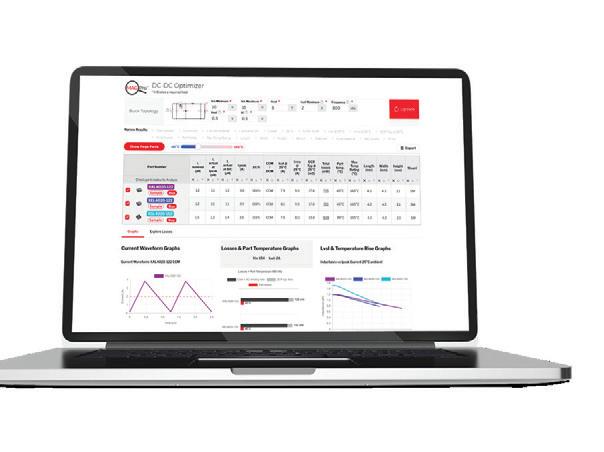
Josh Mickolio, supplier business development manager-wireless and IoT at DigiKey. DigiKey is both the leader and continuous innovator in the high service distribution of electronic components and automation products worldwide, providing more than 14.9 million components from over 2,400 quality name-brand manufacturers

The success of electronic devices isn’t dependent on how reliant the general public is on them, rather, its success is measured at the very beginning, in the manufacturing stage.When OEMs get faulty products because of defects during the manufacturing stage, a bottleneck effect is created, pushing the problem further along the supply chain, impacting a wider range of people. With defective electrical components making it past this primary stage, and at risk of mounting potential monetary loss, what can OEMs do to ensure trust that they will receive a reliable product?
Cybord, the visual AI platform ensuring the reliability of 100% of electronic components is the quality assurance needed to refine the manufacturing process, ensuring that OEMs will receive reliable and properly documented electronic components. Fueled by big data, the proprietary inspection system analyzes both the top and the bottom of 100% of electrical components in near real time thereby ensuring the reliability of the end-product without slowing down or halting the manufacturing process.
EP&T sits in conversation with Oshri Cohen, CEO of Cybord to discuss the use and application of his firm’s quality assurance measure.
The most disruptive scenario is when defective or counterfeit
components are not discovered during the production process and wind up in the final product. In these scenarios, it is often the end user who discovers defects in the product, and ultimately pays the price. With that in mind, uncovering a defective part on the production line is a far more desirable scenario than uncovering a problem when a product is in use – especially for life-dependent products, for example, self-driving cars, health devices, or defense and aerospace technologies.
With advancements in visual AI-based traceability and inspection capabilities, we can detect corroded, or otherwise defective components within the assembly process, empowering manufacturers to identify and eliminate these components efficiently, which in turn boosts productivity

and reduces costs by minimizing the scrap and rework rates and providing smooth and efficient product delivery times.
a. Compare that to when discovered after the end-product has entered the consumer market. The cost of eliminating products with defective electronic components increases exponentially with each subsequent stage of the manufacturing and distribution process: While the cost is just x$1 at the component level, it rises to x$100 during a product rework, and up to x$1000 when recalling items already in the field. Therefore, when Cybord’s technology is utilized in the assembly stage, we can mitigate the extent of and even eliminate these extremely costly recalls, which result in
both financial and reputational damage.
2. At what stage of the design cycle does Cybord get involved with OEM or CEM based customers?
The Cybord platform is installed over production lines, therefore analyzing 100% of the components assembled over boards. As such, there is no need to get involved in the design cycle of an OEM. The only setup the system requires is installation of the software over a single server within the production line. Once this installation is completed, all the images taken by P&P and AOI machines are transferred to this server and analysis is performed within a few seconds.
a. Are there different inventory controls implemented with CEM-based customers at the management level, and operations level?
CEMs follow strict inventory control methods to reduce the risk of getting the wrong parts. However, with all these efforts invested, there is no way to physically see the condition of each and every individual component while it goes to the CEM inventory. Even if the CEMs are able to review every component before it goes to storage, it will not be very useful as they can never know how long the component will be stored and what its condition will be on the day it will be used. The Cybord platform utilizes the assembly stages and performs such component inspection from both the top and bottom component sides a fraction of a second before the component is placed over the board.This way, we overcome the risk of missing any defects developed during the storage period.
3. What would you say have been the main issues behind fake part infiltration into the global supply chain?
As we have seen recently, geopolitical events and decisions significantly impact the supply chain and the availability of materials and components we have come to rely on for everyday
Production floor tool aggregates, analyzes data from 100% of the componentsPhoto: Cybord
life. Simultaneously, there is a continuous growing demand for assembled boards across industries like health, defense, and automotive. This growing demand derives from the need to support technological innovations like AI, autonomous electric vehicles, and more. With this rising demand, the fabs capacity to produce legacy products using older tech (silicon based on older then 16nm tech) is not increasing. Most of the new investments are being made to establish new tech fabs so there is a severe shortage of legacy products. This limited supply and rising demand leads to an influx of new suppliers trying to provide a stopgap, and defective parts entering the supply chain and affecting the overall quality of the final products. Supply chain issues are cyclical, and we expect ups and downs and fluctuations. The best and most effective way to tackle the challenge of maintaining component quality amid ‘down’ periods is through utilizing big data and AI. In doing so, we can ensure that whatever components do make their way into the supply chain, whether locally or internationally sourced, they undergo inspection to ensure that they are of the highest quality and can be consumed safely.
4. How important is it to have open communication or transparency between different players in the supply chain?
Communication between manufacturers and suppliers is more cr itical now than ever. Quite often the industry operates on trust; manufacturers obtain components from suppliers they believe are historically trustworthy. Transparency between the manuf acturers and the end customers is critical. Such transparent communication and supportive relationships will reduce the chances of end customers experiencing severe shortages and will reduce the need of these end customers to improvise by trying to get their hands on materials from the open market.
5. How important is it for OEMs and CEMs to implement quality control measures or adequately enforce those measures at every stage of the production process?
Statistics have shown that approximately 90% of component failures are associated with visual indications on the components themselves. Therefore, it is crucial for OEMs and EMSs to be able to identify those failures, verify that each component is sourced from a reliable source, and ensure that the homogeneity level within the same reel is high, free from any visual defects, oxidation, or mold evidence, at the assembly stage. Catching these defective components early on, increases the productivity of the manufacturing process, ensures reliable end products, and enhances the manufacturers’ bottom lines. Our platform is able to provide complete inspection of 100% of the components that go onto a PCBA (Printed Circuit Board Assembly) and deliver the kind of surgical traceability needed in a zero-trust supply chain environment.
6. Are there any design sectors that benefit from increasing quality control over others. (i.e. military, medical, IoT, automotive, etc.)
With the growing ubiquity of chip integration in everyday electronic products, everyone who builds and integrates electronic boards into their products needs such a system. The Cybord platform addresses concerns facing OEMs and EMSs across almost all verticals. We see our system utilized by Tier 1 OEMs, Tier 1 automotive manufacturers, defense contractors, health tech manufacturers, and DataCom
companies. In Industry 4.0, visual AI inspection is no longer ‘nice to have,’ but rather a must to serve manufacturers across the board and ensure product quality and reliability through 100% inspection and surgical traceability of electronic components
7. How does Cybord utilize AI and Big Data technology to eliminate electronic component failures?
Relying on AI and big data analytics, Cybord’s solution looks at both the top and bottom of components and analyzes visual data and production metadata from the production line to ensure authenticity, quality, reliability, and visual traceability of all electronic components. Our platform seamlessly connects to component assembly machines, allowing for near real-time inspection of 100% of components a fraction of a second before the assembly process onto the boards is complete. By examining all components within the assembly process, Cybord’s solution empowers customers to identify and eliminate faulty components, which in turn minimizes costly disruptions of the assembly line, reduces the scrap/rework rate of assembled boards, and ensures smooth and efficient product delivery times. The platform works with standard assembly machines, making it compatible with virtually every assembly line in the world.
a. How does it differ from other inventory methods currently available?
All of the other methods implemented in the industry today sample only a few components from every few reels or trays to verify which are good. Cybord’s solution reviews and analyzes 100% of the components

assembled. Other methods require the implementation of new additional machines, which cost a lot and require a re-layout of the production lines and modifications to the production process. The Cybord platform is totally transparent as it is a software-only solution connected to the existing assembly machines over the lines. The software-only Cybord AI platform is installed onto a dedicated server within the factory, which collects all images from existing surface-mount technology machines (SMT) and automated optical inspection (AOI) machines. This development differentiates us from others as it requires no additional capital investments, hardware, or other modifications to production line layouts to deliver quality assurance and chip reliability.
Current production lines that have implemented the Cybord solution provide a surgical traceability level as part of the system output.
Our technology is a software solution built specifically to integrate with pre-existing SMT and AOI machines, making it a seamless installation. Cybord collaborates with the biggest machine manufacturers in the world to receive component images to add to our database and improve our AI identification system, which does not require any delays or modifications to existing lines. By working directly with the machine manufacturers to feedback the machines with the relevant analysis results, our customers benefit from our technology while using the existing machine interfaces.
CINCH
FIBRECO range of expanded beam fiber-optic connectors provide high performance, flexible, cost-effective solutions to critical harsh environment communication applications such as defence, aerospace, security, offshore, mining, outside broadcast and other industrial applications. Product range includes expanded beam cable assemblies that utilize connectors such as Fibreco Junior, Mini & Senior and D38999, as well as Stratos HMA connectors.

https://www.belfuse.com/ product-detail/fibreco-fibreco
HARTING
3D-MID component carrier is firm’s in-house development which serves as a connecting element between a printed circuit board (pcb) and electronic components (such as LEDs, ICs, photo–diodes or sensors). Product takes the fullest advantage of the benefits of 3D-MID technology. A precise injection-moulded component ensures that electronic components can be inserted at exactly 90° to a pcb. The flexibility of the laser direct structuring process enables the creation of customised layouts.
Sensors and
ICs are precisely and fully automatically mounted on the component carrier in the desired configuration.
https://3d-circuits.com/en
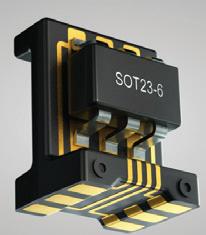
NXP
NMH1000 Magnetic Sensor Switch meets today’s market needs by replacing traditional bulky mechanical switches that are unsuitable for difficult environmental conditions. Device delivers distinctive features, flexible application and ability to easily onboard. Device is most sensitive to the magnetic fields that vertically pass through the top-to-bottom surfaces. Input consists of a magnetic field ranging in strength from earth-bound background, up to maximum BGMAX. Its input processing consists of functional blocks such as a configurable state machine, analog-to-voltage conversion of the input and comparison to generate the output, arranged in linear succession.
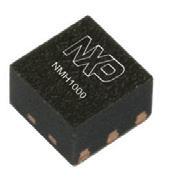
https://www.nxp.com
AMBIQ
Neural Network Speech Enhancer (NNSE) is an open-source AI model built on firm’s neuralSPOT AI SDK. Product includes all the code needed
for training, testing, and deploying on the Apollo4 Plus SoC to help AI developers de-noise applications in minutes. This highly optimized AI model effectively removes background noise from speech on the device in real time, allowing clean speech capture in noisy environments.
NNSE includes scripts and tools to help developers add speech de-noising capabilities to their applications.

https://github.com/AmbiqAI/ nnse

TELEDYNE LECROY
WaveMaster 8000HD high-bandwidth, high-definition oscilloscope (HDO) platform with models from 20 to 65GHz of bandwidth, 12 bits of resolution, up to 320GS/s of sample rate and an industry-leading 8 gigapoints (Gpts) of acquisition memory. Product retains the unrivaled validation and debug
HAMMOND MANUFACTURING
1591T series multipurpose polycarbonate enclosures deliver a transparent look and are suitable housings for printed circuit boards (pcbs) and small electronics. Available in clear, translucent blue and translucent red, products are molded with card guides to accept 1.5 mm PC cards. When applications require the ability to see instruments, LEDs, readouts, and other indicators, product series makes it possible to securely house these electronics while retaining the inside visibility.

capabilities of its predecessor while adding new SDA Expert serial data analysis software options for testing next-generation serial data technologies. Oscilloscopes provide improved signal characterization performance for next-generation serial data technologies, such as PCIe 6.0 and USB4 Specification v2.0.
https://www.teledynelecroy. com/oscilloscope/wavemaster-hd
https://www.hammfg.com/ electronics/small-case/plastic/1591t
ENABLES
KEYSIGHT TECHNOLOGIES
Eggplant Test 7.0 is an enhanced version of the automated software test solution with powerful integrations that enable quality assurance (QA) teams to test mobile apps on multiple devices and operating systems simultaneously. Software provides integrations that can test more than 7,500 operating system and device combinations through Sauce Labs’ Real Device Cloud. The
latest version offers QA teams advanced collaboration features, seamless integration with continuous integration tools, and the ability to connect with virtualized applications.
https://www.keysight.com/us/ en/product/EG1000A/eggplant-test.html


SEMICONDUCTOR
CRU24715-600 (600V, with dual common cathode 15A rectifiers) and CRU24730-600 (600V, with dual common cathode 30A rectifiers) through-hole hyper-fast recovery rectifiers packaged in the TO-247 provide outstanding performance

SILANNA SEMICONDUCTOR
www.bourns.com/products/ magnetic-products/power-inductors-smd-high-current-shielded

and couple perfectly with firm’s upcoming line of Super junction MOSFETs. Devices boast a fast trr of 35nSec at a VR of 30V and IF at 1A with a di/dt=300A/us. With the dual die configuration, devices can use a single leg, either pin 1 or pin3 for 15A or 30A IF (AV) rating, or double the limit by using pin 1 and pin 3 in parallel to 30A or 60A IF (AV) rating. https://www.centralsemi.com/ featured-products/40

JARO
Model 12025 ARGB cooling fan optimizes both gaming performance and hardware longevity. The single-phase, 4-pole cooling fan comes in a 120 X 120 X 25mm package, while providing a cool 71.18CFM of super-cooled air. At the same time, this 12Vdc gaming cooler provides a (MTTF) life-expectancy of 1,000,000 Hours (at 40? /65% RH). Devices also provide robust AImatched controls through a user AI system that automatically adjusts fan speeds and lighting effects based on
SZDL3105BB-EVB02 buck converter evaluation board helps engineers quickly build and test 100W end-to-end fast charger applications built around firm’s CO2 Smart Power family of wide-voltage, high-frequency point of load converters. Device is configured for a 5V to 20V at 5A output and integrates all necessary connections to properly test and evaluate the efficiency and other performance metrics. A range of compatible daughter boards ensures rapid configuration of a variety of USB-PD and QC charging use cases.

I-PEX
I-PEX LIGHTPASS series multi-mode active optical connector modules include a silicon photonics IC, ‘IOCore’, which was developed by AIO Core Co. Ltd. and operates reliably in high temperature environments. The ultra-small products enable bi-directional optical communication for the purpose of photoelectric conversion of internal high-speed signals in large data centre and telecommunication equipment. LIGHTPASS-EOB II 128G is designed for data transmission in applications such as network interface cards, base stations, and airplane cabin wiring.


GIGALANE
GDBC series one piece 2nd generation one-piece GDBC direct board contacts have a simple one-piece design enabling a high integration and miniaturization of board-toboard and board-to-module RF interconnections. Contacts are very easy to use in the assembly as they require no SMT. Device provides a solution for multiple connections and complex stack ups in 5G systems. Devices technical details include a frequency from dc up to 8.5GHz, impedance of 50�, insulation resistance of 5000M� and a dielectric withstand voltage of 750Vrms. VSWR is 1.12:1 at 3.0GHz, 1.22:1 at 6.0GHz and 1.35:1 at 8.5GHz.
https://www.powell.com
https://powerdensity.com/ reference-design/
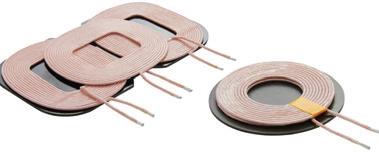
BOURNS
Model SRP1038CC, SRP1245CC, SRP1265CC, SRP1770CC, SRP2313CC, SRP3012CC, SRP3020CC, SRP4012CC, SRP4020CC, SRP5020CC, SRP5030CC and SRP7028CC Series power inductors are manufactured to provide engineers with distinct design advantages through either a carbonyl powder core or a metal alloy powder core, shielded construction to provide high saturation and high heating current, low buzz noise and low magnetic field radiation.
The 12 shielded inductor series meets high current density and increased inductor reliability requirements in power electronics designs.
https://www.i-pex.com/library/ news/new-product-release-lightpass-eob-ii-eos-20230803
MASTER BOND
SIGNAL TRANSFORMER
real-time temperature and user data.
https://jarothermal.com/ products/fans/dc-fans/aquas/ jcd12025-120x120x25
EP40TCMed two part, room temperature curing epoxy system meets the requirements of ISO 10993-5 for non-cytotoxicity. Product is thermally conductive, electrically non-conductive and can be utilized as an adhesive or sealant in various medical and wearable device applications. The toughened epoxy delivers an elongation of 60-70%, and it has improved strength properties with a tensile lap shear strength between 2,300 and 2,500 psi, a T-peel strength of 40-60pli and a low tensile modulus of 5,000-15,000psi at room temperature, making it suitable for applications where low stress is needed.
https://www.masterbond.com/ newsrelease/ep40tcmed
WCC series wireless charging transmission coils complies to the Qi open interface standard for power transfer. Devices are available in single, double, and triple windings configurations that comply with the Qi open interface standard for power
transfer. Products allows power to be transferred wirelessly through inductive coupling to charge an array of products including car chargers for vehicle and navigation, phones, tablets, game machines, wearable devices, drones or UAVs.
https://www.digikey.ca/en/ product-highlight/s/signal-transformer/wireless-charging-transmission-coils-wcc-series
Rockwell Automation Inc., a leading global player dedicated to industrial automation and digital transformation, has signed a definitive agreement to acquire Waterloo-based Clearpath Robotics Inc., a leader in autonomous robotics for industrial applications.
Clear path’s OTTO Motors Division offers AMRs and fleet management and navigation software, which dramatically increases throughput and reduces costs by ensur ing components and subassemblies are in place when needed and by transporting finished goods to a truck or warehouse upon completion.
StenTech Inc., a multinational SMT printing solutions firm, has acquired Photo Etch Technology, a leading stencil manufacturer.
Photo Etch Technology, along with its affiliate Utz Technologies, specializes in making high-quality SMT stencils, mesh screens, and parts for both OEM and contract manufacturing customers. With facilities in four key U.S. markets, Photo Etch has established a strong foothold in the industry. The deal adds to StenTech’s existing footprint in Silicon Valley and New England.
Future Electronics Inc. has been sold for more than $5-billion to Taiwanese semiconductor distributor WT Microelectronics Co. The agreement includes 100% of Future’s shares in an all-cash deal expected to close in the first half of 2024.
A global distributor of electronics components, Quebec's business registry lists Future Electronics as wholly owned by Robert Miller that employs 5,200 workers across 47 countries. Co-founded by Miller in 1968, the Montreal-based corporation says it generated US$2.9 billion in revenue and US$184 million in profits in the first half of 2023.

Ametek Inc. has acquired United Electronic Industries (UEI), a leading provider of data acquisition and control solutions for the aerospace, defense, energy and semiconductor industries.
UEI specializes in the design and manufacture of high-performance test, measurement, simulation and control solutions that enable customer s to build smart, reliable, flexible and rugged systems. The company’s products are used in a variety of mission critical applications, including flight simulation and training,
machine health and usage monitoring, and automated testing.
PEI-Genesis, a global player in the design and assembly of custom engineered interconnect solutions, recently achieved its AS9100D and ISO9001:2015 certification at its Philadelphia-based facility solely focused on the assembly and delivery of D-Sub connectors.
The certification is the recognized standard for quality management systems administered through the International Standards Organization (ISO) and SAE. It marks a company’s commitment to focusing on improving quality and increasing customer satisf action. PEI-Genesis underwent comprehensive audits to assess the alignments of its quality management system set forth by ISO. By obtaining this accreditation, PEI-Genesis can develop, manufacture, and sell products for aviation, space and defense organizations. Throughout 2023, PEI-Genesis will onboard other industry leading D-Sub connector manufacturers, such as Amphenol PCD, Positronic, and Cinch Connectivity Solutions, to expand and broaden its product offer ings.
TTI Inc. has signed an agreement to become an authorized distr ibutor of Kyocera Display products, including a wide variety of TFT and memory in pixel displays, furthering TTI’s expansion into the industrial, medical and eMobility markets
“The Kyocera brand and its portfolio of TFT and MIP technologies further strengthens our position in the optoelectronics display market segment,” Geoff Imlach, vice president of sales for TTI Americas.
Kyocera Industrial TFT
displays feature high contrast, color saturation and enhanced performance enhancements such as advanced wide viewing (AWV) for true color fidelity, super-high brightness (SHB) and wide temperature range.
TTI also recently became an authorized distributor of Cree LED, which produces a broad portfolios of application-optimized LED components, targeting the lighting, eMobility and industr ial markets.
Cree product families include the XLamp and J Series LEDs for general and specialty lighting applications and high brightness LED products for video screens, signage and specialty lighting applications.
element14 along with NI have launched an educational program that aims to equip its community members with valuable skills in LabVIEW prog ramming and automated testing, enabling users to build new projects.
The course titled: ‘A Beginner’s Course in LabVIEW and Test Automation,’ is a widely used graphical programming environment that facilitates the development of automated research, validation, and production test systems.
Global distributor Mouser Electronics Inc. is now offering the latest products from Raspber ry Pi. Sourced directly from Raspberry Pi, the entire catalog of single-board computer s (SBC), embedded devices, and peripherals is available from Mouser, with full traceability/authenticity from the manufacturer.
“With their line of industrial-ready products, customers across the globe now have access to an expanded offering of innovative, scalable products that are cer tified, low-cost, powerful and production ready," said Andy Kerr, Mouser VP of supplier marketing.

lead-times have returned. Over 2 million cords and components currently in-stock which ship the same day ordered. Why wait for reliable power?





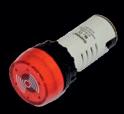


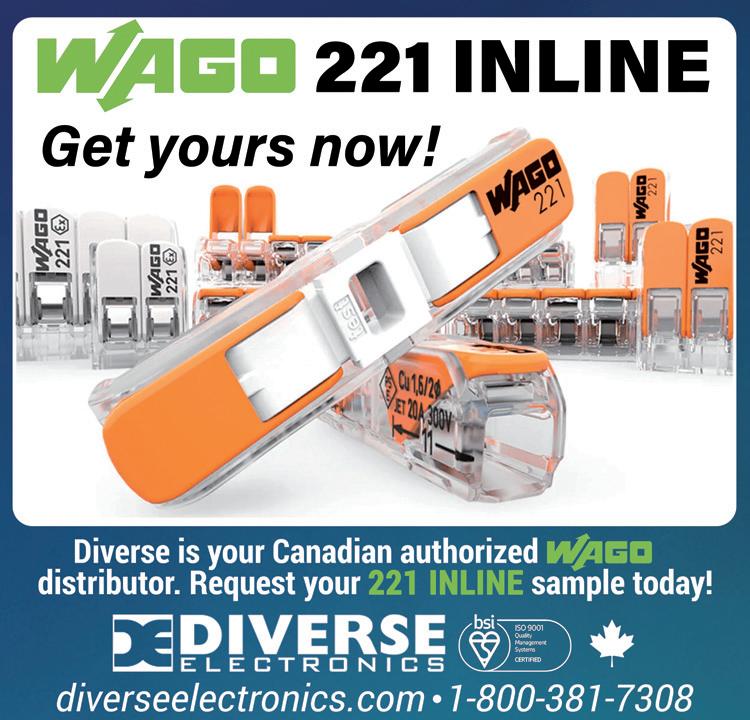






VENDOR: BEAGLEBONE
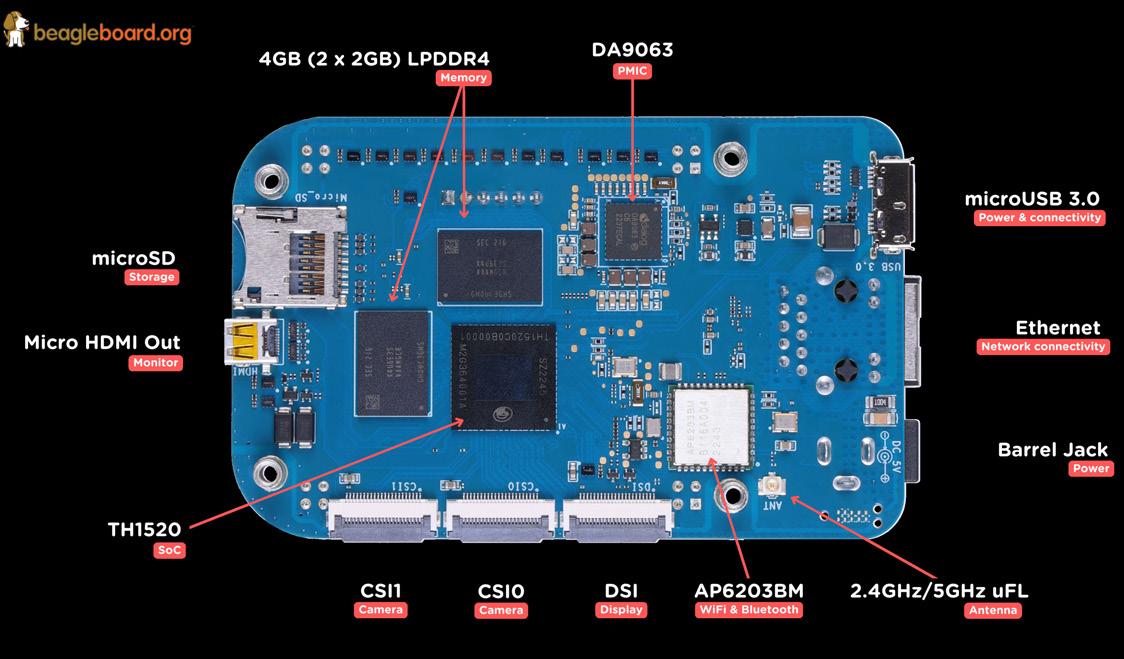
This open-source RISC-V single board computer (SBC) comes in the form factor of BeagleBone Black with compatible P8 & P9 cape header pins allowing users to stack their favorite BeagleBone cape on top to expand its capability. Featuring a powerful quad-core RISC-V processor, BeagleV-Ahead is designed as an affordable RISC-V enabled pocket-size computer for anybody who want’s to dive deep into the new RISC-V ISA.

Processor: T-Head TH1520 (quad-core Xuantie C910 processor)
PMIC: DA9063
• Memory: 4GB LPDDR4
Storage: 16GB eMMC
• WiFi/Bluetooth:
• PHY: AP6203BM
• Antennas: 2.4GHz & 5GHz
• Ethernet :
PHY: Realtek RTL8211F-VD-CG Gigabit
Ethernet phy.
Connector: integrated magnetics RJ-45
• microUSB 3.0
Connectivity: USB OTG, Flash support
• Power: Input: 5V, Output: 5V
HDMI
• Transmitter: TH1520 Video out system
Connector: micro-HDMI (type-D)
Other Connectors
• microSD
• mikroBUS shuttle connector (I2C/UART/ SPI/ADC/PWM/GPIO)
• 2 x CSI connector compatible with BeagleBone AI-64, Raspberry Pi Zero / CM4 (22-pin)
DSI connector
Chipset Features
• Alibaba T-Head TH1520 SoC
• 2GHz quad-core RISC-V 64GC Xuantie C910
• 3-issue 8-execution superscalar with out-of-order issue/completion/retirement
64KB I and 64KB D L1 per core
• 1MB shared L2 cache
4TOPS@INT8 neural processing unit (NPU) @ 1GHz
50GFLOPS, 3Mpixel/s Imagination
BXM-4-64 graphics processing unit (GPU)
• 2x image signal processor (ISP)
• Video codecs
• H. 265/H.264 @ 4Kp75 decode
H. 265/H.264 @ 4Kp40 encode
Scan here to view more information.
Our annual Electrosource Buyers Guide is now available exclusively online, making it easier than ever to search for electronics suppliers. To ensure this new online offering is the most accurate, please update your company information today.

Hammond has over 20 million dollars of in-stock inventory and over 16,000 unique product skus to choose from.
Low voltage power transformers, high-end audio transformers and chokes, medical grade isolation.


Diecast aluminum, extruded aluminum, and plastic enclosures in thousands of sizes and configurations.

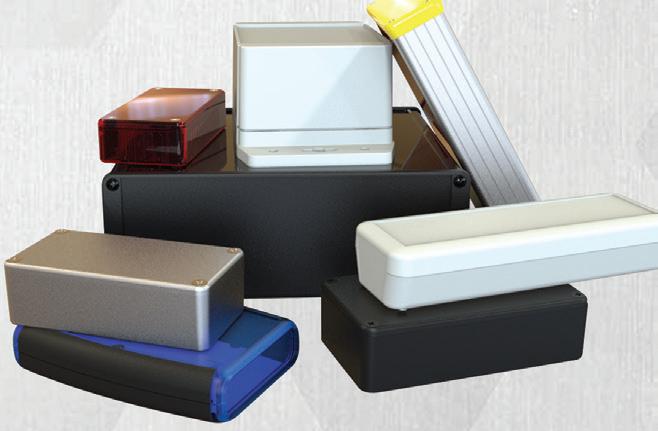
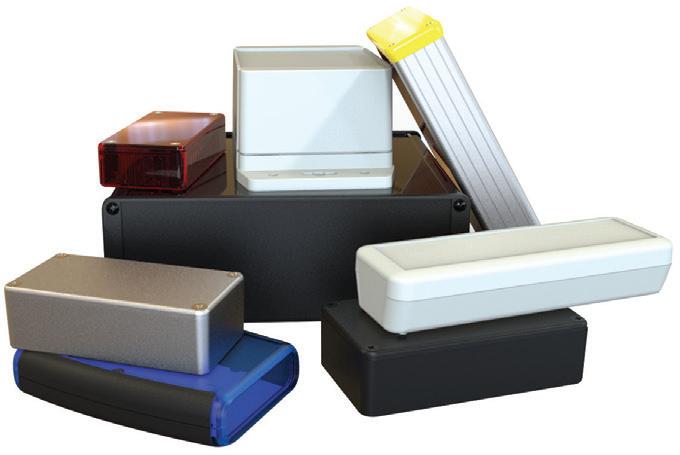





Junction, wall mount, and freestanding enclosures in painted steel, stainless steel, aluminum and non-metallic.
15A and 20A heavy duty outlet strips for commercial/industrial, rack mount, and benchtop applications.


19” racks, cabinets, and accessories for test & measurement, data communications and more.
